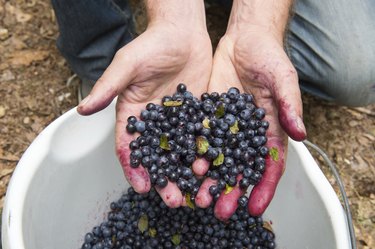
Blueberries (Vaccinium spp.) have steadily become an important crop for many southern states. Varieties that were native to that area of the country have been cultivated to grow in increasingly warmer climates. South Carolina is one of many states where blueberries can be grown in great quantities thanks to modern gardening.
Varieties to Choose
Video of the Day
South Carolina includes only U.S. Department of Agriculture plant hardiness zones 7 and 8. While two types of blueberries can grow in the state, rabbiteye (Vaccinium ashei) and southern highbush (Vaccinium darrowii), only rabbiteye berries are recommended for the home grower. Southern highbush blueberries can grow between zones 6 and 10, but are much higher maintenance, have a short life span, require frost protection in cooler areas of the state and have a host of health problems -- making them a risky choice for the home grower. Rabbiteye varieties are easy to grow, are adaptable to their environment, have up to a 50-year life span, are disease resistant with few pests and can be grown in USDA zones 6 through 9.
Video of the Day
Some varieties of rabbiteye well-suited to the variety of regions in South Carolina include "Brightwell" and "Baldwin." "Climax" is an excellent producer, though best grown outside of the mountain regions. Northern regions where spring freeze is more likely should chose "Centurion" or "Brightblue" which are most frost-resistant.
Planting Conditions
Blueberries prefer loose,acidic soils high in organic material with an optimal pH between 4.0 and 5.5 in a full-sun location. North Carolina has various kinds of soil spread across the state, but few of them meet this criteria. Amend soil by adding organic material, which will help to loosen and aerate it. Till organic matter like peat moss or pine bark into the first 8 inches of soil. A 10-by-10-foot garden needs 8 cubic feet of organic materials laid on top and then tilled in. Use a 7-by-7-foot well-drained, full sun area for planting each rabbiteye bush. Further increase the acidity in the area by mulching with pine bark or needle mulch. Spread the mulch in a 4-foot circle around each plant about 2 to 3 inches deep.
Some soils in the Piedmont area are very high in manganese which can be toxic to your blueberries. It is best to have a soil test done before planting to determine the nutrient levels as well as pH.
Clay Soils and Water
Blueberries do not like to be soggy, but the high clay content found in many areas of South Carolina leave them water logged and diseased. To amend this problem, use a half-and-half mixture of peat moss and sand to create a 6-inch high mound for planting. You may secure the mound with gardening bricks or landscape timbers. This mound will dry much faster than the surrounding clay, so, depending on rainfall and temperature, water up to two to three times a week to keep your blueberry bush well-hydrated.
Fertilization Needs
Fertilization is important, but blueberries can be very sensitive to excess amounts. It is best to spread fertilization out over the course of the year rather than deliver it in one fell swoop. In the first year, apply 1 ounce of 10-10-10 fertilizer in a 12-inch circle around the plant once leaves sprout. Repeat this every six weeks until the end of the summer. In the second year, double the rates and increase the circle to 18 inches. For fruit-bearing plants, increase this cycle to 1 cup of 10-10-10 fertilizer in a 3-foot circle. You may add 1/4 cup of ammonium nitrate to the six-week intervals to encourage more vigorous growth, but stop this by July.